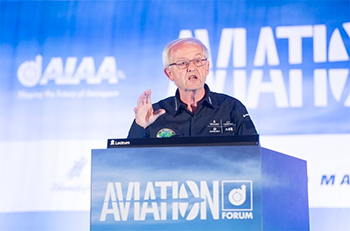Around the World in 6 Months on Nothing but Solar Power Written 6 June 2017
Speaker: Hannes Ross, consultant, Solar Impulse Project
by Duane Hyland, AIAA Communications (2008-2017)

The success of the Solar Impulse 2 aircraft’s flight around the world demonstrates we can have technology that saves energy and uses clean energy sources, Hannes Ross, a consultant with the Solar Impulse Project, said June 5 during the Wright Brothers Lecture in Aeronautics at the 2017 AIAA AVIATION Forum in Denver.
“We have technologies available right now to save energies and to provide new clean energies today,” Ross said, adding that the Solar Impulse concept wasn’t designed to be used for commercial flights but to send a message: “We must use these energies ... to leave the world for the next generation.”
Ross took the audience through a brief history of solar trips around the globe and the path to the Solar Impulse program — from Ferdinand Magellan’s sailing expedition to Bertrand Piccard and Brian Jones’ hot air balloon ride and beyond.
“Maybe looking back is always a good thing to do to learn what other people have ... done before,” he said.
The team first conceived Solar Impulse 2 and designed it in 2011. The aircraft was tested in 2014, and its worldwide flight began in March 2015. It made 16 stops and crossed both the Pacific and Atlantic oceans. In July 2016, it became the first aircraft powered only by electricity generated by solar power technology to circumnavigate the globe.
Ross explained the entire design, manufacturing and flight process of Solar Impulse 2. He also discussed the logistics involved in staging a flight around the world — from working with various air traffic control agencies to arranging customs clearances in all the nations the flight visited.
“Wherever we landed, we had quite a bit of spare parts along,” Ross said. “We had our own kitchen … and all of that had to be brought into the country and taken away, and everything needed to be checked by customs.”
He said the team even had to design a portable, inflatable hangar big enough to accommodate the aircraft’s 71.9 meter, or 236 foot, wingspan to shelter the plane on its various stops.
Of the Solar Impulse team, Ross said: “They are all very proud to have been able to participate in such a successful program.”
